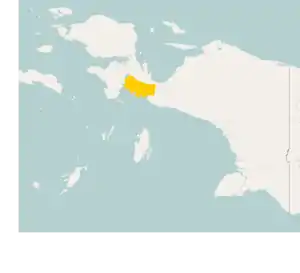Mairasi languages
The Mairasi languages, also known as Etna Bay[1] are a small independent family of Papuan languages in the classifications of Malcolm Ross and Timothy Usher, that had been part of Stephen Wurm's Trans–New Guinea proposal. They are named after Etna Bay, Indonesian New Guinea.
| Mairasi | |
|---|---|
| Etna Bay | |
| Geographic distribution | Etna Bay, Kaimana Regency, West Papua |
| Linguistic classification | One of the world's primary language families |
| Glottolog | mair1253 |
 Distribution of the Mairasi languages | |
Languages
The Mairasi languages are clearly related to each other.
- Mairasi family: Semimi, Mer, Mairasi, Northeastern Mairasi
Classification
Mairasi cannot be linked to other families by its pronouns. However, Voorhoeve (1975) links it to the Sumeri (Tanah Merah) language, either a language isolate or an independent branch of the Trans–New Guinea family.
Pawley and Hammarström (2018) do not consider there to be sufficient evidence for the Mairasi languages to be classified as part of Trans-New Guinea, though they do note the following lexical resemblance between Mairasi, Semimi, and proto-Trans-New Guinea.[2]
- Mairasi ooro and Semimi okoranda ‘leg’ < proto-Trans-New Guinea *k(a,o)nd(a,o)C ‘leg’
Phonemes
Usher (2020) reconstructs the consonant inventory as follows:[3]
*m *n *ɸ *t *s *k *mb *nd *ns *ŋg *w *ɾ *j
Vowels are *a *e *i *o *u. *ns is uncommon.
Pronouns
Usher (2020) reconstructs the free and possessive pronouns as:[3]
sg pl 1excl *omo, *o- *eme, *e- 1incl *e-tumakia, *e- 2 *neme, *ne- *keme, *ke- 3 *nani, *na- ?
Basic vocabulary
Some lexical reconstructions by Usher (2020) are:[3]
gloss Proto-Etna Bay hair/feather *-suɾu ear *ɸiɾa eye *mbiatu nose *-mbi tooth *-ɾasi tongue *-saɸia foot/leg *-koɾa blood *iseɾe bone *tuɾa skin/bark *(na)-kia breast *joku louse *kumai dog *ansi pig *[ɸ]embe bird *sai egg *ete man/male *koɸo woman *eɸei sun *tende moon *aŋgane water *ɸat[e] fire *iɸoɾo stone *jaɸutu path *kae name *u[w]ata one *tana-(kau) two *amoi
Cognates
Basic vocabulary of Mairasi languages (Mairasi, Mer, Semimi) with cognate matches, from Peckham (1991a,b), quoted in Foley (2018):[4][5][6]
Mairasi family basic vocabulary gloss Mairasi Mer Semimi ‘bird’ sai sai sai ‘blood’ isere isere monad ‘bone’ natura singgu natura ‘breast’ jogu jogu jogu ‘ear’ navir anda nevira ot navira[note 1] ‘eat’ neneman namba neneme ‘egg’ eːte ede anggu ete ‘eye’ nambutu nembiatu ombiatu ‘fire’ ivore ivoro iforo ‘give’ tomnaijan nombonaiyomo tomonai ‘ground’ wasasai wasase makoro ‘hair’ nasuru nasuru nasuru ‘hear’ ivjeme iveme iveme ‘I’ ʔomo omo omo ‘leg’ naʔor nakora okor anda ‘louse’ ʔumai kumai kumai ‘man’ tatʔovo neum tato tatokovo ‘moon’ unsir anggane anggane ‘name’ nggwata wata newata ‘one’ tanggau nawaze tanakau ‘path, road’ ʔae kae kai ‘see’ natom daviomo nondome ‘stone’ javutu wavo javutu ‘sun’ tende ungguru tende ‘tongue’ nasavia nesavi osavi ‘tooth’ narasi nerasi orasi ‘tree’ ʔiu u ʔu ‘two’ amoi amoi amoi ‘water’ fata kai fate ‘we’ eːme edumaga ʔeme ‘woman’ evei waini efei ‘you (sg)’ ʔeme kene keme
Usher's protoforms of the 20 most-stable items[7] in the Swadesh list include the following.[3]
Proto-Mairasi gloss *kumai louse *amoi two *ɸat[e] water *-ɸiɾa ear ? die *o-mo I ? liver *-mbiatu eye *-ɸaka hand/arm *iɸi- hear ? tree *uɾatu fish *u[w]ata name *jaɸutu stone *-ɾasi tooth *joku breast *ne-me you *kae path *-tuɾa bone *-saɸia tongue
Vocabulary comparison
The following basic vocabulary words are from Voorhoeve (1975),[8] as cited in the Trans-New Guinea database:[9]
gloss Mairasi Semimi head neŋguvu kotera hair eŋguasa nasuru eye ne-mbutu -mbiato tooth nerasi n-erasi leg oʔoro okoranda louse umai kumai dog asi ansi pig bembe pembe bird sai sai egg ete aŋgu-ate blood isere monda bone natura natura skin n-aiʔa kakia tree iwo u man tatovo tatakovo sun tende tende water fata fate fire ivoro iboro stone javutu jahutu name negwata nawata eat nenem- nenem- one taŋggau tana two amoi amoi
See also
References
- NewGuineaWord Etna Bay
- Pawley, Andrew; Hammarström, Harald (2018). "The Trans New Guinea family". In Palmer, Bill (ed.). The Languages and Linguistics of the New Guinea Area: A Comprehensive Guide. The World of Linguistics. 4. Berlin: De Gruyter Mouton. pp. 21–196. ISBN 978-3-11-028642-7.
- New Guinea World, Etna Bay
- Peckham, Lloyd. 1991a. Etna Bay survey report: Irian Jaya Bird’s Neck languages. Workpapers in Indonesian Languages and Cultures 10: 147–185.
- Peckham, Lloyd. 1991b. Mairasi phonology. Workpapers in Indonesian Languages and Cultures 10: 111–145.
- Foley, William A. (2018). "The languages of Northwest New Guinea". In Palmer, Bill (ed.). The Languages and Linguistics of the New Guinea Area: A Comprehensive Guide. The World of Linguistics. 4. Berlin: De Gruyter Mouton. pp. 433–568. ISBN 978-3-11-028642-7.
- Holman, Eric W., Søren Wichmann, Cecil H. Brown, Viveka Velupillai, André Müller, Dik Bakker (2008). "Explorations in Automated Language Classification". Folia Linguistica, Vol. 42, no. 2, 331–354
- Voorhoeve, C.L. Languages of Irian Jaya: Checklist. Preliminary classification, language maps, wordlists. B-31, iv + 133 pages. Pacific Linguistics, The Australian National University, 1975. doi:10.15144/PL-B31
- Greenhill, Simon (2016). "TransNewGuinea.org - database of the languages of New Guinea". Retrieved 2020-11-05.
External links
- Mairasi languages database at TransNewGuinea.org
- Timothy Usher, New Guinea World, Proto–Etna Bay